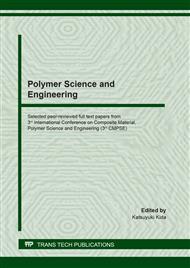p.33
p.41
p.47
p.53
p.59
p.66
p.72
p.78
p.84
Mechanical Enhancement and Thermal Stability of Composites between Polyamide 11 and Functionalized Graphene Nanoplatelets
Abstract:
The composites between polyamide 11 (PA11) and functionalized graphene nanoplatelets (GNP) were prepared to compare influence of GNPs content and functionalities; hydroxyl (GO) and carboxylic acid (GC); on mechanical and thermal properties. The composites were melt compounded and injection molded into specimens with the final GNP content of 1, 3, 5, 7 and 9 wt%. It was found in XRD that these plasma-exfoliated GNPs acted as the nucleating agents that changed the crystal form of PA11, but did not have significant influence on crystallinity content. DSC analysis confirmed the nucleating effect of GNPs, which the degree of crystallinity was not affected by the presence of GNPs. The functionalities of GNP did not reduce the degradation temperature of the composites compared to neat PA11. Young's modulus and tensile strength at yield of the composites were higher with respect to the GNP content. This was attributed to stretching restriction of polymer chains by GNPs during the elastic deformation. The composites adding GO had higher tensile properties than those adding GC. In contrast, the composites adding GC showed higher impact strength than those adding GO. SEM micrographs indicated the failure of the composites occurred at the interphase between PA11 matrix and GNPs.
Info:
Periodical:
Pages:
59-65
Citation:
Online since:
August 2020
Keywords:
Price:
Сopyright:
© 2020 Trans Tech Publications Ltd. All Rights Reserved
Share:
Citation:


